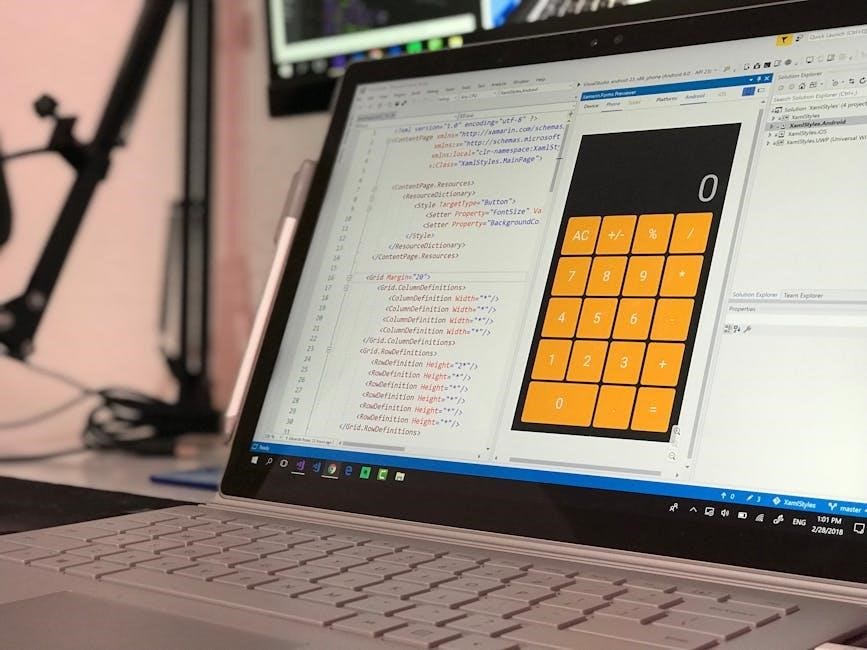Starting Out with Programming Logic and Design 6th Edition PDF: A Comprehensive Guide
Embark on your programming journey with the 6th Edition of Tony Gaddis’ renowned guide. This resource introduces core concepts and problem-solving techniques‚ emphasizing a language-independent approach. Discover how to access the PDF version and leverage its improved pedagogy for effective learning and exploration of programming fundamentals.
Overview of Programming Logic and Design
Programming logic and design form the bedrock of software development‚ providing a structured approach to problem-solving. This foundational discipline transcends specific programming languages‚ enabling learners to grasp core principles applicable across various platforms. It emphasizes the creation of algorithms and flowcharts to visualize program structure before diving into code.

The “Starting Out with Programming Logic and Design” series aims to demystify these concepts‚ offering a step-by-step guide for beginners. By focusing on the underlying logic‚ it equips aspiring programmers with the ability to tackle complex challenges with confidence. The book introduces fundamental programming topics without the added complexity of language syntax.
Key elements include understanding input‚ processing‚ and output‚ as well as mastering control structures like sequence‚ selection‚ and iteration. These building blocks enable the creation of robust and efficient programs. Furthermore‚ the series introduces object-oriented concepts‚ preparing learners for modern software development practices. The language-independent approach ensures that the skills acquired are transferable and enduring‚ regardless of the programming language chosen. This makes it an ideal starting point for anyone venturing into the world of software development.
Key Concepts Covered in the Book
The 6th edition of “Starting Out with Programming Logic and Design” comprehensively covers essential programming concepts. It begins with fundamental building blocks like variables‚ data types‚ and operators‚ laying the groundwork for understanding more complex topics. Control structures‚ including sequential‚ selection (if/else)‚ and repetition (loops)‚ are explained in detail‚ enabling students to create programs with branching and iterative logic.
The book delves into modularization‚ teaching students how to break down large problems into smaller‚ manageable functions or subroutines. This promotes code reusability and improves program organization. Array processing is also thoroughly covered‚ providing techniques for storing and manipulating collections of data. Advanced concepts such as file I/O are introduced‚ allowing programs to interact with external data sources.
Furthermore‚ the book introduces the principles of object-oriented programming (OOP)‚ including classes‚ objects‚ encapsulation‚ inheritance‚ and polymorphism. These OOP concepts are presented in a clear and accessible manner‚ preparing students for developing object-oriented applications. Throughout the book‚ emphasis is placed on problem-solving strategies‚ algorithm design‚ and the importance of clear and maintainable code. The improved pedagogy in the 6th edition ensures a gradual and effective learning experience.
Target Audience and Learning Objectives
“Starting Out with Programming Logic and Design‚ 6th Edition” is primarily aimed at individuals with little to no prior programming experience. It serves as an excellent introductory text for students in computer science or related fields‚ as well as self-learners seeking to grasp the foundational principles of programming. The book’s language-independent approach makes it suitable for anyone regardless of their chosen programming language.

The primary learning objective is to equip readers with the ability to think logically and solve problems using computational techniques. Upon completing the book‚ learners should be able to design algorithms‚ create flowcharts‚ and translate those designs into functional code. They will understand fundamental programming concepts such as variables‚ data types‚ control structures‚ and functions.
Furthermore‚ the book aims to introduce readers to object-oriented programming (OOP) principles‚ enabling them to create modular and reusable code. Students will learn how to analyze problems‚ develop solutions‚ and implement those solutions using sound programming practices. Ultimately‚ the goal is to provide a solid foundation in programming logic and design‚ preparing learners for more advanced programming courses or real-world software development projects. The 6th edition ensures these objectives are met through improved pedagogy and clear explanations.
Tony Gaddis: The Author
Tony Gaddis is a highly respected and widely recognized name in the field of introductory programming education. As the author of “Starting Out with Programming Logic and Design‚” as well as numerous other popular programming textbooks‚ Gaddis has dedicated his career to making programming accessible to beginners. His writing style is known for its clarity‚ simplicity‚ and step-by-step approach‚ which has helped countless students overcome the initial challenges of learning to code.
Gaddis holds a Bachelor’s degree in Computer Science and a Master’s degree in Instructional Technology. Before becoming a full-time author‚ he taught computer science courses at both the university and community college levels‚ giving him firsthand experience with the difficulties that students face when learning programming. This experience has informed his writing‚ allowing him to anticipate common pitfalls and provide clear‚ effective explanations.
Beyond “Starting Out with Programming Logic and Design‚” Gaddis has authored successful textbooks on Python‚ C++‚ Java‚ and Visual Basic. His books are characterized by their practical examples‚ hands-on exercises‚ and comprehensive coverage of fundamental concepts. Gaddis’s commitment to education and his ability to connect with students have made him one of the most influential authors in the field of introductory programming. The 6th edition continues to reflect his dedication to providing a high-quality learning experience.

Importance of Logic and Design in Programming
The importance of logic and design in programming cannot be overstated. These foundational elements are crucial for creating effective‚ efficient‚ and maintainable software. Before writing a single line of code‚ a programmer must first carefully consider the problem at hand and devise a logical plan to solve it. This involves breaking down complex tasks into smaller‚ more manageable steps‚ and then outlining the sequence of operations required to achieve the desired outcome.

A well-designed program is not only easier to write but also easier to understand‚ debug‚ and modify. By focusing on logic and design‚ programmers can avoid common pitfalls such as infinite loops‚ incorrect calculations‚ and unexpected errors. Furthermore‚ a solid understanding of these principles enables programmers to write code that is both elegant and efficient‚ making optimal use of system resources.
In the context of “Starting Out with Programming Logic and Design‚” the emphasis on these fundamentals provides a strong foundation for students to build upon as they progress in their programming careers. By mastering the art of logical thinking and program design‚ aspiring programmers can develop the skills necessary to tackle even the most challenging software projects. This focus ensures that students learn to think like programmers‚ rather than simply memorizing syntax.
Language-Independent Approach
A key strength of “Starting Out with Programming Logic and Design 6th Edition” lies in its language-independent approach. This methodology focuses on teaching the fundamental principles of programming logic and design‚ rather than tying the concepts to a specific programming language. By abstracting away the complexities of syntax and language-specific features‚ the book allows students to concentrate on the core skills that are essential for any programmer.
This approach is particularly beneficial for beginners who may feel overwhelmed by the sheer number of programming languages available. Instead of getting bogged down in the details of a particular language‚ students can learn the underlying logic and design principles that apply across all programming paradigms. This includes concepts such as variables‚ data types‚ control structures‚ algorithms‚ and object-oriented programming.
By mastering these language-independent concepts‚ students will be well-prepared to learn any programming language they choose. They will have a solid foundation in problem-solving and program design‚ which will enable them to quickly adapt to new languages and technologies. Furthermore‚ this approach fosters a deeper understanding of programming as a whole‚ rather than simply learning the syntax of a particular language. This makes the book a valuable resource for anyone seeking to build a strong foundation in programming.
Benefits of Using the 6th Edition
The 6th Edition of “Starting Out with Programming Logic and Design” offers several significant benefits for students and educators alike. One of the primary advantages is its updated content‚ which reflects the latest trends and best practices in the field of computer science. The book has been thoroughly revised to ensure that it remains relevant and aligned with industry standards;
Another key benefit is the improved pedagogy‚ which is designed to enhance the learning experience. The 6th Edition features a more gradual introduction to complex concepts‚ making it easier for students to grasp the fundamentals of programming logic and design. The book also includes a wealth of examples‚ exercises‚ and practice problems that reinforce the material and help students develop their problem-solving skills.
Furthermore‚ the 6th Edition benefits from Tony Gaddis’ clear and engaging writing style. Gaddis has a knack for explaining complex topics in a way that is easy to understand‚ even for beginners. He uses real-world examples and analogies to illustrate key concepts‚ making the material more relatable and accessible. The book also includes helpful diagrams and illustrations that further clarify the concepts being presented. By using the 6th Edition‚ students can gain a solid foundation in programming logic and design.
Improved Pedagogy in the 6th Edition
The 6th Edition of “Starting Out with Programming Logic and Design” showcases significant improvements in its pedagogical approach‚ aiming to facilitate a more effective learning experience for beginners. One notable enhancement is the gradual introduction of complex concepts. Instead of overwhelming students with advanced topics early on‚ the book progressively builds upon foundational knowledge‚ ensuring a solid understanding of core principles before moving forward. This step-by-step approach helps learners grasp the material more easily and reduces the risk of feeling lost or discouraged.
Another key improvement lies in the expanded use of examples and exercises. The 6th Edition includes a wealth of practical examples that illustrate how programming logic and design principles can be applied in real-world scenarios. These examples help students connect theoretical concepts to practical applications‚ making the material more relevant and engaging. Additionally‚ the book features a variety of exercises and practice problems that allow students to test their understanding and develop their problem-solving skills.
Furthermore‚ the 6th Edition incorporates visual aids and diagrams to enhance comprehension. Complex concepts are often easier to understand when presented visually‚ and the book makes effective use of diagrams and illustrations to clarify key ideas. These visual aids help students visualize the relationships between different concepts and improve their overall understanding of programming logic and design. With the improved pedagogy‚ students will learn faster.
Availability of PDF Version
The digital age has brought about numerous convenient ways to access educational materials‚ and “Starting Out with Programming Logic and Design‚ 6th Edition” is no exception. The PDF version of this comprehensive guide is readily available‚ offering students and educators a flexible and portable learning solution. This digital format allows users to access the book on various devices‚ including computers‚ tablets‚ and smartphones‚ making it easier to study anytime‚ anywhere.
The availability of the PDF version also provides cost-saving opportunities. Digital textbooks often come at a lower price point than their physical counterparts‚ making education more accessible to a wider range of individuals. Students can save money on textbook costs while still benefiting from the complete content and features of the 6th Edition.
Furthermore‚ the PDF version offers enhanced searchability and navigation. Users can quickly search for specific keywords‚ concepts‚ or examples within the book‚ saving time and effort. The digital format also allows for easy bookmarking and highlighting‚ enabling students to personalize their learning experience and focus on the areas that require more attention. The PDF version enhances the accessibility of this material.
The digital accessibility enhances the learning experience and makes this resource more valuable.
Where to Find Free PDF Downloads

The quest for free PDF downloads of “Starting Out with Programming Logic and Design‚ 6th Edition” often leads to various corners of the internet. It’s important to exercise caution and prioritize ethical and legal practices when seeking such resources. While some websites may offer free PDF downloads‚ it’s crucial to verify the legitimacy and safety of these sources to avoid copyright infringement and potential malware risks.
One avenue to explore is open educational resources (OER) repositories‚ which provide openly licensed educational materials that are free to use and distribute. These repositories may contain versions of the textbook or supplementary materials that align with the content of the 6th Edition. Additionally‚ some educational institutions or libraries may offer access to digital textbooks through their online platforms‚ providing students with legitimate and free access to the material.
However‚ it’s essential to be wary of unofficial websites or file-sharing platforms that claim to offer free PDF downloads of copyrighted material. Downloading copyrighted content without permission is illegal and unethical‚ and it can expose users to legal consequences and security threats. Instead‚ consider exploring alternative options such as renting the e-book‚ borrowing a physical copy from a library‚ or purchasing the textbook from authorized retailers.
The pursuit of knowledge should always be coupled with integrity and respect for intellectual property rights.
Ethical Considerations for Downloading PDFs
When seeking access to “Starting Out with Programming Logic and Design 6th Edition PDF‚” it’s crucial to consider the ethical implications of your actions. Downloading copyrighted material without proper authorization is a violation of copyright law and undermines the rights of the author and publisher. While the allure of a free PDF may be tempting‚ it’s essential to recognize the potential harm caused by such actions.
Ethical considerations extend beyond legal boundaries. Supporting authors and publishers through legitimate purchases ensures the continued creation of valuable educational resources. When we respect intellectual property rights‚ we contribute to a sustainable ecosystem that fosters innovation and knowledge dissemination.
Moreover‚ downloading PDFs from unofficial sources can expose your devices to security risks. These files may contain malware or viruses that can compromise your personal information and damage your system. Protecting your digital security is an ethical responsibility‚ as it safeguards not only yourself but also those connected to your network.
Before resorting to unauthorized downloads‚ explore alternative options such as borrowing the book from a library‚ renting the e-book‚ or purchasing a legitimate copy. By making ethical choices‚ you demonstrate integrity‚ support the creative community‚ and protect yourself from potential harm. Remember that access to knowledge should be obtained through lawful and responsible means.

Alternative Resources for Learning Programming Logic

While “Starting Out with Programming Logic and Design 6th Edition PDF” is a valuable resource‚ numerous alternative avenues exist for acquiring programming logic skills. Online platforms like Coursera‚ Udemy‚ and edX offer structured courses on fundamental programming concepts‚ often taught by experienced instructors. These courses frequently include interactive exercises and projects to reinforce learning.
Websites such as Khan Academy and Codecademy provide free introductory programming tutorials‚ covering various languages and paradigms. These platforms are excellent for beginners seeking a gentle introduction to coding. Additionally‚ many universities and colleges offer open educational resources (OER) that include lecture notes‚ assignments‚ and other materials related to programming logic.
Books beyond Gaddis’s work can also provide valuable insights. Exploring different authors and teaching styles can broaden your understanding. Don’t overlook the power of community. Online forums‚ such as Stack Overflow‚ and local programming meetups offer opportunities to ask questions‚ share knowledge‚ and collaborate with fellow learners.
Consider exploring visual programming tools like Scratch‚ which allow you to learn programming concepts through a drag-and-drop interface. These tools can be particularly helpful for visual learners. By leveraging a combination of these alternative resources‚ you can create a well-rounded learning experience tailored to your individual needs and preferences‚ enhancing your grasp of programming logic.

Pearson’s Commitment to Accessibility
Pearson‚ the publisher of “Starting Out with Programming Logic and Design 6th Edition PDF”‚ demonstrates a strong commitment to ensuring that its educational materials are accessible to all learners‚ including those with disabilities. This commitment is reflected in various initiatives and practices aimed at creating inclusive learning experiences. Pearson strives to adhere to web accessibility guidelines‚ such as the Web Content Accessibility Guidelines (WCAG)‚ to make its digital content usable by individuals with visual‚ auditory‚ motor‚ and cognitive impairments.
Specifically‚ Pearson works to provide alternative text for images‚ captions for videos‚ and transcripts for audio content. They also focus on creating content that is navigable using assistive technologies like screen readers. Furthermore‚ Pearson actively seeks feedback from users with disabilities to identify areas for improvement and enhance the accessibility of its products.
Pearson’s dedication extends beyond mere compliance with accessibility standards. They actively promote awareness of accessibility issues within the educational community and encourage educators to adopt inclusive teaching practices. This holistic approach ensures that all students have the opportunity to succeed‚ regardless of their individual needs‚ aligning with the principles of diversity‚ equity‚ and inclusion. By prioritizing accessibility‚ Pearson aims to create a more equitable and effective learning environment for everyone.

